
South Vienna Center for Cosmology and Astrophysics
We ARE Amateur Grade
Abstract -- Thursday, Aug. 13, 2015
Project scientists were stunned when our colleague, Justin, targeted M51 with the 16-inch Dobsonian in less than two minutes. This was only his second night as a professional astronomer with the South Vienna Center for Cosmology and Astrophysics. Now during my own second night out, I had trouble getting a bright star into the field of view. To be fair, I was only 12 years old with a dime-store f/10 60mm refractor. Enough excuses, I guess. Justin did similarly well with M13. So Justin's a natural. Big deal. I'm good, too. I deserve some credit. And of course Terry is our acknowledged targeting master, with a steady hand and eyes the size of dinner plates. His account of the evening may be found at the end of the list of objects we observed.
NGC 6522 and NGC 6528
| Designation | Constellation | R.A. | Dec | Distance | Mass | Radius | Apparent Size | Apparent Mag |
|---|---|---|---|---|---|---|---|---|
| NGC 6522 | Sagittarius | 18h 3m 34.1s | -30o 2' 2.3" | 25,100 ly | 3.0 x 105 M☉ | 35 ly | 5.6' | 8.6 |
| NGC 6528 | Sagittarius | 18h 4m 49.6s | -30o 3' 20.8" | 21,500 ly | 1.3 x 105 M☉ | unknown | 3.7' | 9.5 |
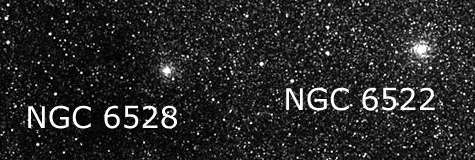
I confess, it wasn't really the science that drove me to this pair of objects. It was the delectable chance to see two nice globular clusters share the eyepiece field. Fortunately, the southern sky was beautifully black and the weather was going our way. We were rewarded with a sight that looked very much like the photo to your left.
NGC 6522 has a long and venerable history in the annals of observation. Discovered by William Herschel on June 24, 1784, it is a fairly bright globular cluster known to amateurs and professionals for two centuries. It was none other than Walter Baade who first noted the metal-poor nature of this cluster in the galactic bulge. An indication of its extreme age (about 12 billion years), such clusters have presented difficulties for cosmological theories that demand a younger universe. This cluster may well be the oldest in the Galaxy. It holds clues to the early chemical enrichment of our Galaxy. An analysis of the cluster's metallicity is available on the Cornell University arXiv server.
That very same night in 1784 William Herschel added the fainter of these two globular clusters to his catalog, describing it as a "faint nebula." And, in fact, we see a similar situation here: another very old, but metal-rich, globular cluster associated with the galactic bulge. The two certainly make a handsome pair in the eyepiece.
M22
| Designation | Constellation | R.A. | Dec | Distance | Mass | Radius | Apparent Size | Apparent Mag |
|---|---|---|---|---|---|---|---|---|
| M22, NGC 6656 | Sagittarius | 18h 36m 23.94s | -23o 54' 17.1" | 10,600 ly | 2.9 x 105 M☉ | 50 ly | 32' | 5.1 |
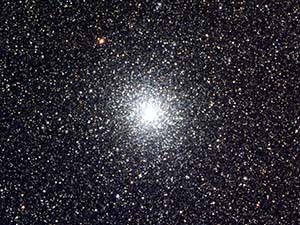
M22, or NGC 6656, is one of the closest globular clusters (10,600 ly) and also the brightest globular appearing in the northern hemisphere. These facts are deceptive, though. Due to its southerly declination, and its superposition over the galactic bulge, M22 does not put on the show that M13 does. Another ancient, metal-poor, galactic bulge cluster -- this object holds some surprises. It is one of only four known globular clusters containing a planetary nebula. It's interesting that an old cluster (again, about 12 billion years) would be home to a blue planetary nebula barely 6000 years old. In addition, two black holes (each less than 20 solar masses) have been detected.
Its brightness and large angular size undoubtably contributed to its early discovery: it was first described by Abraham Ihle on Aug. 26, 1665. Since that time it has been studied intensely, notably by Harlow Shapley (1930) and by Halton C. Arp (1959). We here at the SVCCA had discovered its charms many times. It is a great object for amateur telescopes.
M28
| Designation | Constellation | R.A. | Dec | Distance | Mass | Radius | Apparent Size | Apparent Mag |
|---|---|---|---|---|---|---|---|---|
| M28, NGC 6626 | Sagittarius | 18h 24m 32.89s | -24o 52' 11.4" | 17,700 ly | 5.51 x 105 M☉ | 30 ly | 11.2' | 7.66 |
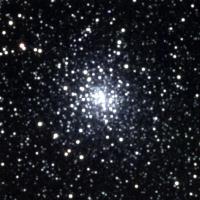
M28 (or NGC 6529) is home to the first millisecond pulsar discovered in a globular cluster. Eleven more have since been found. And so it is that M28 harbors the 3rd largest collection of pulsars of any known globular. It is also home to 18 RR Lyrae variable stars.
This is yet another object first found by Charles Messier, this one on July 27, 1764. A popular and relatively easy target for star-hopping amateurs, it lies less than one degree above the tip-top star of the "teapot" asterism.
M8
| Designation | Constellation | R.A. | Dec | Distance | Mass | Size | Apparent Size | Apparent Mag |
|---|---|---|---|---|---|---|---|---|
| M8 | Sagittarius | 18h 3m 37s | -24o 23' 12" | 4100 ly | unavailable | 110 x 59 ly | 90' x 40' | 6.0 |
The first of four bright emission nebulae we'll talk about tonight, this one was discovered by Giovanni Hodierna sometime before 1654. Also known as the "Lagoon Nebula," it is really big -- about 90 x 40 minutes of arc. Consider that the full moon is only about 15 arc minutes wide. Justly slightly too dim to be a naked-eye object, it is also a fine sight for binoculars.
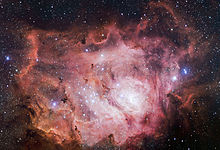
There is plenty of interesting astrophysics going on here. Bok globules are visible. These are dark, collapsing clouds of material that give birth to new stars. Also detected (in 2006) are Herbig-Haro objects -- bright gas jets emited from young stars.
While all these nebulae are wonderously fine spectacles in the amateur's telescope, they will appear grey or white to the eye. The color images here are available only to the photographer's lense (or mirror!). They are captured via extremely long exposures done in color, or more commonly, by three separate exposures through three different color filters. The resultant images are then "stacked" to produce a color image.
M20
| Designation | Constellation | R.A. | Dec | Distance | Mass | Size | Apparent Size | Apparent Mag |
|---|---|---|---|---|---|---|---|---|
| M20 | Sagittarius | 18h 2m 23s | -23o 1' 48" | 5200 ly | unavailable | 42 ly | 28' | 6.3 |
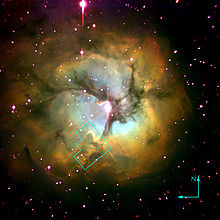
M20, the Trifid Nebula (or NGC 6514), is a rather peculiar object. Its name means "divided into three lobes." As you might guess by now, it too was discovered by Charles Messier -- on June 5, 1764. Officially an emision nebula, it also displays the features of reflection nebula (the blue tufts in the center of the photo) and features of dark nebula (the black bands separating the lobes).
M17
| Designation | Constellation | R.A. | Dec | Distance | Mass | Size | Apparent Size | Apparent Mag |
|---|---|---|---|---|---|---|---|---|
| M17 | Sagittarius | 18h 20m 26s | -16o 10' 36" | 5000 ly | unavailable | 15 ly | 11' | 6.0 |
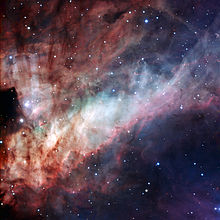
This rather V-shaped H II emission nebula hides behind a variety of aliases: Omega Nebula, Swan Nebula, Checkmark Nebula, and the Horseshoe Nebula. I'm guessing it either has bad credit or an outstanding bench warrant. A wispy and beautiful thing through the telscope, it was discovered in 1745 by Philippe Loys de Cheseaux. One of the most massive star-forming regions in our Galaxy, it is considered to be similar to the great Orion Nebula -- only seen from the edge rather than face-on. It is home to the open cluster NGC 6618 which contributes to its luminosity. More than a thousand stars are in formation on its outer regions.
M16
| Designation | Constellation | R.A. | Dec | Distance | Mass | Size | Apparent Size | Apparent Mag |
|---|---|---|---|---|---|---|---|---|
| M16 | Serpens | 18h 18m 48s | -13o 49' 0" | 7000 ly | unavailable | 70 x 55 ly | 7' | 6.0 |
The Eagle Nebula -- ha! Perhaps telescopes were not so good back then, but I'm guessing that whoever gave it this name was himself nicknamed "The Weasel."
It was discovered by Jean-Philippe de Cheseaux in 1745-46.
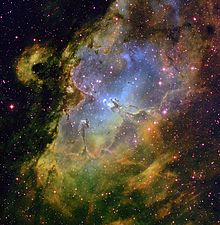 A commanding and awesomely beautiful sight in the 16-inch telescope, this is another stellar nursery, and again, quite bright as these things go. In 1995 researchers
using the Hubble Space Telescope released a spectacular group of images showing portions of this nebula. The audience for these photos soon reached far beyond the
professional and amateur astronomical community and were widely featured in newspaper stories about the Hubble. One widely circulated image showed a pair of gas
columns two light years in length, brightly illuminated by the baby stars they harbored. The image was promptly dubbed "The Pillars of Creation." In truth, it
was breath-taking.
A commanding and awesomely beautiful sight in the 16-inch telescope, this is another stellar nursery, and again, quite bright as these things go. In 1995 researchers
using the Hubble Space Telescope released a spectacular group of images showing portions of this nebula. The audience for these photos soon reached far beyond the
professional and amateur astronomical community and were widely featured in newspaper stories about the Hubble. One widely circulated image showed a pair of gas
columns two light years in length, brightly illuminated by the baby stars they harbored. The image was promptly dubbed "The Pillars of Creation." In truth, it
was breath-taking.
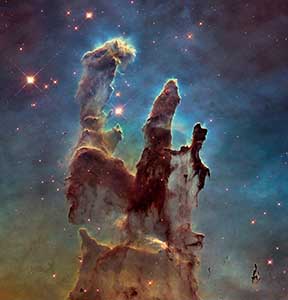
Perhaps people were hungry for a moment of spirituality in a materialist society. Perhaps, recalling the drudgery of their last trigonometry course, they just never realized that all the sciences have their mystical moments that are filled with insights and with magic. I think they were just tired of searching for the face of Jesus on their tacos. At any rate, in letters to the editor, in endless dispiriting water-cooler conversations, I was stupefied by the number of symbols, saints, and sacred jellyfish that friends and coworkers had found depicted in an H II emission region. So popular was this photograph that in 2014 the Hubble repeated it as a tribute to the original, this time in higher resolution and combining visible light with the near-infrared. There is even a 3-D video.
Ironic though it is, O Faithful, I must tell you that The Pillars of Creation are no more. You see, a supernova went off in that gaseous cloud about 9,000 years ago. Its merciless and pestilential light reached the earth, and then faded about 2,000 years ago. The shockwave, however, propagates much more slowly than light. It was detected by the Spitzer Space Telescope in 2005. And it has had 7,000 years, more than enough time, to screw over The Pillars of Creation. So if you stay up very late, about 1000 years past your bedtime, you'll be able to witness their destruction from Earth.
M51
| Designation | Constellation | R.A. | Dec | Distance | Mass | Radius | Apparent Size | Apparent Mag |
|---|---|---|---|---|---|---|---|---|
| M51, NGC 5194, Arp 85 | Cannes Venatici | 13h 29m 52.7s | +47o 11' 43" | 2.3 x 107 ly | 1.6 x 1011 M☉ | 43,000 ly | 11.2' x 6.9' | 8.4 |
Now I'm a galaxy hunter, addicted to chasing down faint little smudges that don't look terribly thrilling. Here is a dramatic exception. Not only a bright galaxy, but an interacting pair of galaxies. There are many interesting features here. Oddly, it was the first galaxy officially classified as a spiral. I say oddly because, as you will see shortly, there is a much brighter and dramatic example. In addition to being a Messier object, it is also an Arp object, Arp 85 to be exact. The Arp Atlas of Peculiar Galaxies is a specialty of mine, but only a few are visible to amateur telescopes. In addition, the larger spiral is also Seyfert galaxy, a class of galaxy with highly active nuclei (AGNs). These objects make up a continuum, the most extreme of which are the quasars. While the optical images were enough to convince me (redshift measurements be damned), it was the radio measurements that unassailably showed this pair was physically interacting.
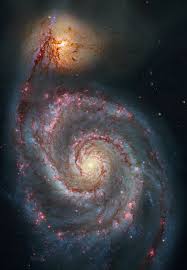
Popularly called "The Whirlpool Galaxy," it was discovered by Charles Messier on Oct. 13, 1773. Pierre Mechain, in 1781, was the first to point out its companion. So now we often refer to the pair of galaxies as M51A (or NGC 5194 -- the large spiral) and M51B (or NGC 5195 -- the smaller companion). While the spiral structure is often plainly visible in our 16" telescope, this detail was not noticed until 1845 when William Parsons first documented it using a mammoth 72" instrument. This object has been often and widely studied over the past couple centuries, producing a published chain of hundreds of both casual and scientific observations. This prodigious literature displays a microcosm of the controversy and cleverness that produces scientific understanding.
This was Justin's first big targeting success. I used a laser pointer to give him an approximate position and then stepped away from the telescope. Only seconds later there was a calm little "I got it!" and I didn't believe him. I viciously kicked the lying rat away from the eyepiece and looked for myself. Sure enough, he got it. I wish I had thought to be polite. It was, in fact, a splendid view. Despite the wispy clouds that were then forming, it was bright, pretty well defined, clear companion, and totally gorgeous. Despite being less than 4 degrees below the very first star in the handle of the Big Dipper, Terry and I both find this target to be a bit challenging. So shooting with a badly-aligned Telrad, and through clouds, he got it. Way to go Justin!
M31
| Designation | Constellation | R.A. | Dec | Distance | Mass | Radius | Apparent Size | Apparent Mag |
|---|---|---|---|---|---|---|---|---|
| M31, NGC 224 | Andromeda | 0h 42m 44.3s | +41o 16' 9" | 2.54 x 106 ly | ~1.5 x 1012 M☉ | 110,000 ly | 190' x 60' | 5.2 |
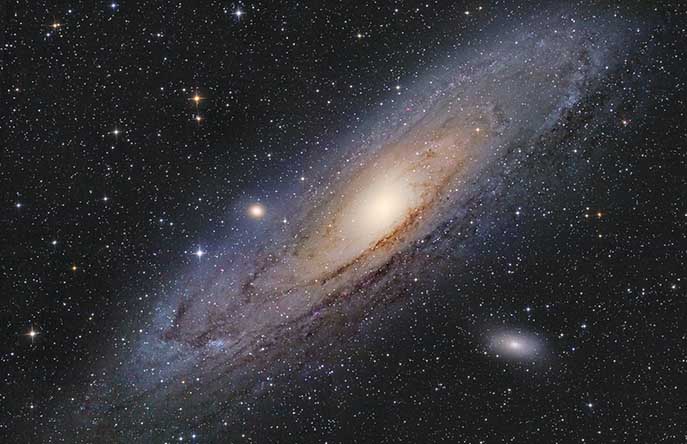
Here is the most spectacular object visible from earth. More exactly it is actually three objects, the Great Spiral in Adromeda (M31) and two small companion galaxies, M110 and M32. Whenever I'm out, and it's up, I simply must look at it. A naked-eye object (if you're lucky), the Persian astronomer Abd al-Rahman al-Sufi wrote a line about it in 964. Known for centuries as "the little cloud," we now enjoy plenty of catalog designations, M31 and NGC 224 being the most common. The first spectrum was obtained in 1864 by William Huggins. A bright-line spectrum overlaid with absorption lines, its stellar nature was clear. The first photograph was obtained in 1887.
Most galaxies belong to "groups," which are simply small clusters. Our own galaxy belongs to the Local Group, which consists of three grand spirals -- M31, M33, and ourselves. Our own galaxy is generally referred to as the Galaxy or as the Milky Way. We do not have a catalog designation! Also in the Local Group are numerous satellite galaxies, about 70 of them detected to date. Our own galaxy, by my own count, has 24 dwarf galaxies orbiting it. M31, at about 2.54 million light years, is the nearest neighboring large galaxy.
While our own galaxy offers us a front row seat to galactic physics and dynamics, so much is obscured by gas and dust. M31 offers us a bird's-eye view of a galaxy similar to our own. M31 has played a pivotal role in our understanding of the universe and its distance scale. Nearly all the greatest astronomers of the last century and all our great observatories have weighed in on the "facts" of M31. So in the literature you will find significant disagreements about exact numbers, an indication of how difficult extragalactic astronomy really is. Here, in an amateur journal, I cannot do justice to the wealth of information gathered, nor to the talents of the individual researchers, nor to the vision of the institutions and nations that funded it. That said, here are some highlights:
- While the number of planets detected outside our solar system now number about 3000, M31 is home to the only planet detected in another galaxy. This was done via observations of gravitational microlensing.
- The first galaxy in which individual stars could be resolved, Edwin Hubble put this property to good use. He identified Cepheid variables and used them to establish that M31 was another galaxy outside our own. This observation settled the "Great Debate" between Heber Curtis and Harlow Shapley. Uncharacteristically, Shapley was wrong.
- Walter Baade demonstrated the stars in M31 belonged to two distinct groups: younger, metal-rich, hot, high-velocity stars (population I) and older, redder, metal-poor stars (population II) belonging to the bulge and globular clusters. This same structure is observed in our own galaxy.
- Walter Baade also realized that there were actually two classes of Cepheid variables, resulting in doubling the distance measurement. We then had the beginnings of the first reliable cosmic distance scale.
- Star counts from the Spitzer Space Telescope (2005) suggest that M31 contains about 1 trillion stars. Depending on which numbers you believe, this would be at least double the stars in our own galaxy.
So once again, we saw it for ourselves. The seeing in that direction was somewhat poor, and it was clouding up, and it was low in the sky. But we've got until spring to enjoy it -- things will only improve. The spiral itself appeared as an oblong blob, about 1/3 its usual apparent diameter. M32 was smudged out, barely discernable in the eyepiece. I could not see spiral structure. M110 was quite clear in the milky sky. We enjoyed it, exclaimed over it, and ate the submarine sandwiches Terry had given us. We moved on.
M55
| Designation | Constellation | R.A. | Dec | Distance | Mass | Radius | Apparent Size | Apparent Mag |
|---|---|---|---|---|---|---|---|---|
| M55, NGC 6809 | Sagittarius | 19h 39m 59.71s | -30o 57' 53.1" | 17,600 ly | 2.69 x 105 M☉
| 48 ly |
19' |
7.42 |
|
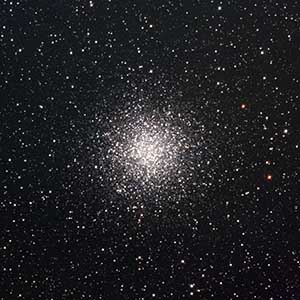
Oh, the scream! Terry is normally a very placid fellow, rich in low-key, rapier-sharp, hateful sarcasm. In the dark, I could not see what was going on. Were there really bears in South Vienna? Had he just accidentally dropped a rock on the primary mirror? I took another bite of my sandwich. If the bear really had him, I should have another couple minutes to dawdle over the Italian lunch meats.
Finding a few shards of unused empathy deep in my psyche, I walked over to the telescope and found Terry still very much alive and unbloodied. He was actually smiling and clearly excited. That spine-stiffening vocalization proved to have been a grotesque parody of joy. Disappointed with the mediocre apparition of M31 in the east, Terry had turned back to the south. He gestured towards the eyepiece, and I looked. M55! Damn! This was only the second time in our lives we had seen it.
Discovered by Nicolas Louis de Lacaille in June 16, 1752 while observing from South Africa, M55 is a very challenging target. Messier had been observing for more than 10 years before he reported on it. M55 was very low on the horizon, there was a tree in the way. There were a million reasons why Terry should not have gotten it. Hence, the scream!
M13
| Designation | Constellation | R.A. | Dec | Distance | Mass | Radius | Apparent Size | Apparent Mag |
|---|---|---|---|---|---|---|---|---|
| M13, NGC 6205 | Hercules | 16h 41m 41.24s | +36o 27' 35.5" | 22,200 ly | 6 x 106 M☉ | 84 ly | 20' | 5.8 |
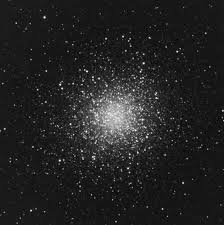
M13 is truely the shining jewel of the northern hemisphere. Other globulars my be brighter and larger. But statistics are unimportant. M13 is sensationally beautiful, its several hundred thousand stars lying far away from the galactic bulge on a coal black background. Graceful little tendrils of stars curl away from the dramatically spherical body of the cluster. Even looking with a single eye through the eyepiece, it looks three dimensional. Here is proof that your own eye delivers a grander and more vivid spectacle than any photograph.
In 1974, to celebrate the refurbishing of the Arecibo radio telescope, the only message ever sent intentionally to contact another civilization was beamed towards M13. 1,679 bits in length, it described the basics of human civilization and the instrument that sent it. Broadcast with a power of 1 million watts and with a tightly focused beam, it is sure to reach the cluster. If anyone is listening, we should hear back from them in about 45,000 years.
M54
| Designation | Constellation | R.A. | Dec | Distance | Mass | Radius | Apparent Size | Apparent Mag |
|---|---|---|---|---|---|---|---|---|
| M54, NGC 6715 | Sagittarius | 18h 55m 3.33s | -30o 28' 47.5" | 87,400 ly | unavailable | 153 ly | 12' | 8.37 |
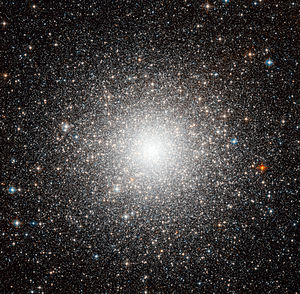
Fresh from his improbable success with M55, Terry decided to ignore the looming horizon (and the darn tree) to attempt the three globular clusters along the base of the teapot. The first of these, M54 is a truely wondrous object. Newer (1994) observations have recalibrated its distance, moving it out to 87,000 light years. This globular does not actually belong to our galaxy! Instead, it appears to belong to one of our satellite galaxies, the Sagittarius Dwarf Elliptical Galaxy. It may even be the core of that faint structure. In 2009, a team of astronomers reported the detection of an intermediate mass black hole in the center of the cluster. So from the time of its discovery by Charles Messier in 1778, its true nature has eluded us until just a couple of decades ago. It is the first, and so far as I know, the only globular cluster to be promoted to extragalactic status!
I think the lesson to be learned here is that the difference between a star cluster and a galaxy are differentiations of scale, morphology, and separation from other distinct objects. When you think about it, most of our sensory distinctions are like that. It is easy enough to distinguish your coffee cup from your desk. But can you say with pin-point accuracy where your wrist stops and your arm begins? Where, exactly, does red stop being red and become orange? So were we looking at a globular cluster or a dwarf E0 galaxy? You be the judge.
M70
| Designation | Constellation | R.A. | Dec | Distance | Mass | Radius | Apparent Size | Apparent Mag |
|---|---|---|---|---|---|---|---|---|
| M70, NGC 6681 | Sagittarius | 18h 43m 12.76s | -32o 17' 31.6" | 29,400 ly | 1.79 x 105 M☉ | 34 ly | 8' | 8.0 |
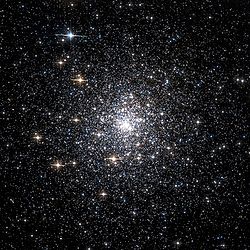
This one, a globular cluster discovered by Charles Messier in 1780, is much closer and really does belong to our own galaxy. Through the telescope it is quite tiny, and, due to its position, the image is loaded with foreground stars. As with the other globulars, we see advanced age and low metallicity. The cluster is home to a young radio pulsar.
M69
| Designation | Constellation | R.A. | Dec | Distance | Mass | Radius | Apparent Size | Apparent Mag |
|---|---|---|---|---|---|---|---|---|
| M69, NGC 6637 | Sagittarius | 18h 31m 23.1s | -32o 20' 53.1" | 29,700 ly | unavailable> | 42 ly | 9.8' | 8.31 |
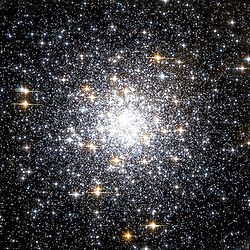
Charles Messier discovered this one on the very same night as he did M70, Aug. 31, 1780. It lies about 1800 light years from M70 -- the two are neighbors! It shows a much broader image than M70, about 9 arc minutes. Astrophysically speaking, the two clusters are rather different -- this one being relatively high in metal content.
Summary
In sum, we might describe this as the night of the globular clusters. I do not think I have ever seen so many in a single evening. It was suprising to me what individuals they are -- each with its own secrets to share. There were some disappointments: poor seeing to the north and poor placement kept us away from M81 and M82. And we were too lazy to break our necks targeting the Ring Nebula at the zenith. Clouds, and the fact that it was a weeknight brought the evening to an end, but it was the most productive in years. Hey -- what's up in September?
Terry and I recognized each other as fellow night watchmen more than 25 years ago. Since then, one of us has rarely been out without the other. Terry keeps meticulous records of every observing session, always emailed out to the participants within a day or two of the event. It was he who first showed me Mercury, Neptune, Uranus, and even Pluto.
Terry's Observing Notes
Terry always carefully documents the objects we've seen along with his own comments on the observing session. His notebook (spreadsheet) covers the entire 25 years we have been observing together. He produces them very quickly, informally -- helping us to cement the memories of the objects we've seen. Here, these comments have been edited very slightly to better fit the context of this presentation:
08/13/2015 Thursday
After achieving the ideal set up at Justin's, it rains for 2 months. Finally, it looks like the new moon in August will be perfect and we plan. But Friday's forecast deteriorates and I sound the alarm for Thursday night. Gary is skeptical, but at 7:30 PM agrees it's a go. We both buy food. Gary shows at 8:30, we load up and are at Justin's by 9:30. Good sport that Justin is (he has to work early on Friday), he joins in all night.
We begin at 10:30. I sight in the Telrad on the tip of the Sagittarius Tea Pot and get 2 small globes: NCC 6522 (8.6 5.6') and NGC 6528 (9.5 3.7'). Then to the top of the pot for M28 (6.9 11.2') and its big brother, my favorite M22 (5.1 24'). I am so happy.
Then to the Lagoon M8 (5.8 90') and the faint Trifid (6.3 29'). I am having great luck with the Telrad so I jump to the Omega M17: bright, (6.0 46') and, finally, the very faint Eagle Nebula M16 (6 35'). We all try for the Andromeda Galaxy but it is too low in the wispy clouds. Justin targets his first object and gets the difficult M51 (9.2 11.1') and its dance partner NGC 5195 (10.6 5.8') low in the sky and very faint. Then back to M31 Andromeda and this time Gary gets it (4 188'). Gary sees both companions M110 (8.9 22') and M32 (9.1 8.8'). I swing back to the best southern sky ever to see M55 for only the 2nd time; big and diffuse at (7.0 19') low in the sky.
Gary and Justin try for M101 but Ursa is too low and it's hazy in that direction. Justin gets his 2nd object M13 (5.9 16.6'). It's high in the sky and sharp. My Telrad pointing luck holds as I swing south again to pick off the 3 globes at the base of the tea pot; M54 (7.7 9.1'), M70 (8.1 7.8') and M69 (7.7 7.1'). I try half heartedly for M75 but it is 12:30 and time to pack it in. We leave by 1:30 and I am home by 2:15. A great night! 18 objects, 15 M's and 3 NGC's. It was the best night in 8 years.

